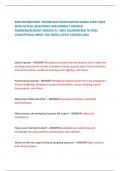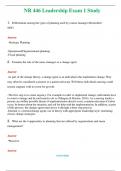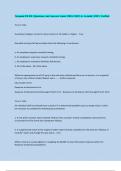NHA PHLEBOTOMY TECHNICIAN CERTIFICATION EXAM LATEST 2024
WITH ACTUAL QUESTIONS AND CORRECT VERIFIED
ANSWERS/ALREADY GRADED A+ 100% GUARANTEED TO PASS
CONCEPTS(ALL WHAT YOU NEED) LATEST EDITION 2024
Safety hazards - ANSWER-Workplaces hazards that are factores which make the
working environment unsafe. Examples include exposed wires, faulty machines
and work surfaces, sockets and wiring, poor lighting, and others.
Psychosocial hazards - ANSWER-Workplace hazards which harm the employee's
mental wellbeing. Examples include discrimination, racism, bullying, sexual
harrassment, and others.
What does OSHA stand for? - ANSWER-Occupational Safety and Health
Administration
What domain do workplace hazards fall under? - ANSWER-Safety and
Compliance
How is each domain tested? - ANSWER-Candidates are asked task and
knowledge focused questions pertaining to each domain.
What are the two types of blood sampling systems? - ANSWER-Open systems
and closed systems
,Closed systems - ANSWER-Used for most routine blood sampling. These include
the use of hypodermic needles and syringes or the use of a vacuum extraction
tube system.
Open systems - ANSWER-These include the use of hypodermic needles and
syringes that have a winged steel needle attached to it.
What does HIPAA stand for? - ANSWER-The Health Insurance Portability and
Accountability Act
When was HIPAA created? - ANSWER-1996
What is HIPAA? - ANSWER-HIPAA is a component of federal laws requiring all
medical records, including electronic and paper records, be kept in confidence
and according to the specific principles of the law.
What is performing laboratory quality control? - ANSWER-This includes
measures, principles, and practices done to remove the risk of error and other
non-conforming outcomes. They ensure the possibility of generating accurate,
prompt laboratory results.
What is the purpose of the principles of workplace safety laid down by OSHA
and NIOSH? - ANSWER-To protect workers from exposure to workplace hazards
Biological hazards - ANSWER-hazards such as viruses, fungi, bacteria, parasites,
mold, sewage, vectors, etc.
Chemical hazards - ANSWER-non-biologic hazardous substances that cause
local and systemic adverse reactions. Examples include reagents, chemical
solutions, drugs, radioactive substances, acids, alkalis, and others.
,Physical hazards - ANSWER-Hazardous environmental factors that put an
individual at risk. Examples include heights, sound, light, heat, and pressure.
Ergonomic hazards - ANSWER-Workplace hazards that are physical factors
which can affect posture and balance and cause musculoskeletal injuries.
Examples include poor sitting and standing postures, ill-fitting work chairs and
desks, constant bending, pulling, squatting, and others.
What are quality control measures used for? - ANSWER-Quality control
measures are used to eliminate errors that can occur in the pre-analytic,
analytic, and post-analytic stages to ensure the generation of accurate, prompt
lab results
Pre-analytic errors - ANSWER-Errors that occur during the collection, transport,
and preparation of test samples.
What are examples of pre-analytic errors? - ANSWER-Sample mix-ups,
mislabeling, improper collection, storage, and transportation of samples.
What are quality control measures used to eliminate errors in the pre-analytic
stage? - ANSWER-The proper collection of blood samples by adhering to the
principles of standard operations, accurate labeling and transportation of
specimens, accurate transportation of test materials in their appropriate
containers and at the right temperatures. It also involves the appropriate
transportation of infectious and toxic samples.
Analytic errors - ANSWER-Laboratory errors which occur during testing and
experimentation
, When can analytic errors occur? - ANSWER-This can occur during the use of
incorrect reagents, the use of defective and non-calibrated equipment, and
failure to adhere to the standard operating procedures.
What are quality control measures taken to eliminate errors in the analytic
stage? - ANSWER-Proper calibration of all laboratory equipment, inventory of
reagents (including their expiration dates), use of test controls, and appropriate
sanctioning of personnel who violate the principles of standard operating
procedures.
Post analytic errors - ANSWER-Errors that occur during the calculation,
recording, and interpretation of results.
What quality control measures can be used to reduce the risk of post-analytical
errors? - ANSWER-The use of appropriate personnel to record and interpret
results, and the use of electronic calculations
What identifying characteristics must sharps' containers have according to
OSHA's Bloodborne Pathogen Standard? - ANSWER-Sharps' containers must
either be labeled with the universal hazard symbol or color-coded red.
When should the contents of a sharps' container be disposed of? - ANSWER-
When the container is 2/3rds full and/or when contents reach the fill line.
What can sharps' containers be made out of? - ANSWER-Sharps' containers can
be made from cardboard, plastic, steel, or polymers, as long as they are
closable, puncture-resistant, leak-proof, and properly labeled or color-coded
According to OSHA standards, what is classified as biohazards/regulated waste?
- ANSWER-A. Liquid and semi-liquid blood and other infectious materials







